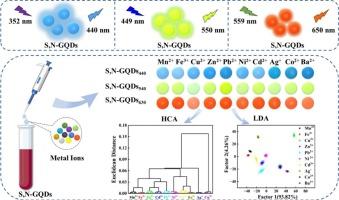A fluorescence sensor array based on triple-color emission S,N-co-doped graphene quantum dots for metal ions discrimination
IF 4.6
2区 化学
Q1 SPECTROSCOPY
Spectrochimica Acta Part A: Molecular and Biomolecular Spectroscopy
Pub Date : 2025-09-24
DOI:10.1016/j.saa.2025.126986
引用次数: 0
Abstract
In recent years, metal ion pollution poses serious threats to human health and ecosystems, so there is a pressing need to develop rapid methods for simultaneous detection of multiple metal ions. Herein, we developed a fluorescent array sensor based on triple-color emission S,N-GQDs (sulfur and nitrogen co-doped graphene quantum dots) for the rapid discrimination and quantitative analysis of 10 metal ions in environmental samples. The triple-color fluorescence emission of S,N-GQDs exhibited distinct responses to different metal ions, which were effectively captured by linear discriminant analysis (LDA) and hierarchical cluster analysis (HCA), thereby facilitating the differentiation of both metal ions and their mixtures. The aforementioned 10 metal ions have been successfully discriminated over a broad concentration range (0–300 μM). Moreover, quantification of metal ions was achieved at a low concentration of 2.03 μM for Mn2+, 0.50 μM for Fe3+, 0.11 μM for Cu2+, 3.92 μM for Zn2+, 0.55 μM for Pb2+, 1.14 μM for Ni2+, 2.10 μM for Cd2+, 0.29 μM for Ag+, 1.14 μM for Co2+ and 0.96 μM for Ba2+. Moreover, the sensor array demonstrated excellent recovery rates for metal ions in water samples (tap water and lake water), indicating great application prospects in environmental water monitoring.

基于三色发射S, n共掺杂石墨烯量子点的金属离子识别荧光传感器阵列。
近年来,金属离子污染对人类健康和生态系统造成严重威胁,迫切需要开发多种金属离子同时检测的快速方法。在此,我们开发了一种基于三色发射S,N-GQDs(硫氮共掺杂石墨烯量子点)的荧光阵列传感器,用于快速识别和定量分析环境样品中的10种金属离子。S,N-GQDs的三色荧光发射对不同的金属离子表现出不同的响应,通过线性判别分析(LDA)和层次聚类分析(HCA)有效地捕获了这些响应,从而促进了金属离子及其混合物的区分。上述10种金属离子在较宽的浓度范围(0 ~ 300 μM)内被成功分辨。此外,在Mn2+ 2.03 μM、Fe3+ 0.50 μM、Cu2+ 0.11 μM、Zn2+ 3.92 μM、Pb2+ 0.55 μM、Ni2+ 1.14 μM、Cd2+ 2.10 μM、Ag+ 0.29 μM、Co2+ 1.14 μM和Ba2+ 0.96 μM的低浓度下,实现了金属离子的定量。此外,该传感器阵列对水样(自来水和湖水)中的金属离子具有优异的回收率,在环境水监测中具有广阔的应用前景。
本文章由计算机程序翻译,如有差异,请以英文原文为准。
求助全文
约1分钟内获得全文
求助全文
来源期刊
CiteScore
8.40
自引率
11.40%
发文量
1364
审稿时长
40 days
期刊介绍:
Spectrochimica Acta, Part A: Molecular and Biomolecular Spectroscopy (SAA) is an interdisciplinary journal which spans from basic to applied aspects of optical spectroscopy in chemistry, medicine, biology, and materials science.
The journal publishes original scientific papers that feature high-quality spectroscopic data and analysis. From the broad range of optical spectroscopies, the emphasis is on electronic, vibrational or rotational spectra of molecules, rather than on spectroscopy based on magnetic moments.
Criteria for publication in SAA are novelty, uniqueness, and outstanding quality. Routine applications of spectroscopic techniques and computational methods are not appropriate.
Topics of particular interest of Spectrochimica Acta Part A include, but are not limited to:
Spectroscopy and dynamics of bioanalytical, biomedical, environmental, and atmospheric sciences,
Novel experimental techniques or instrumentation for molecular spectroscopy,
Novel theoretical and computational methods,
Novel applications in photochemistry and photobiology,
Novel interpretational approaches as well as advances in data analysis based on electronic or vibrational spectroscopy.

 求助内容:
求助内容: 应助结果提醒方式:
应助结果提醒方式:


